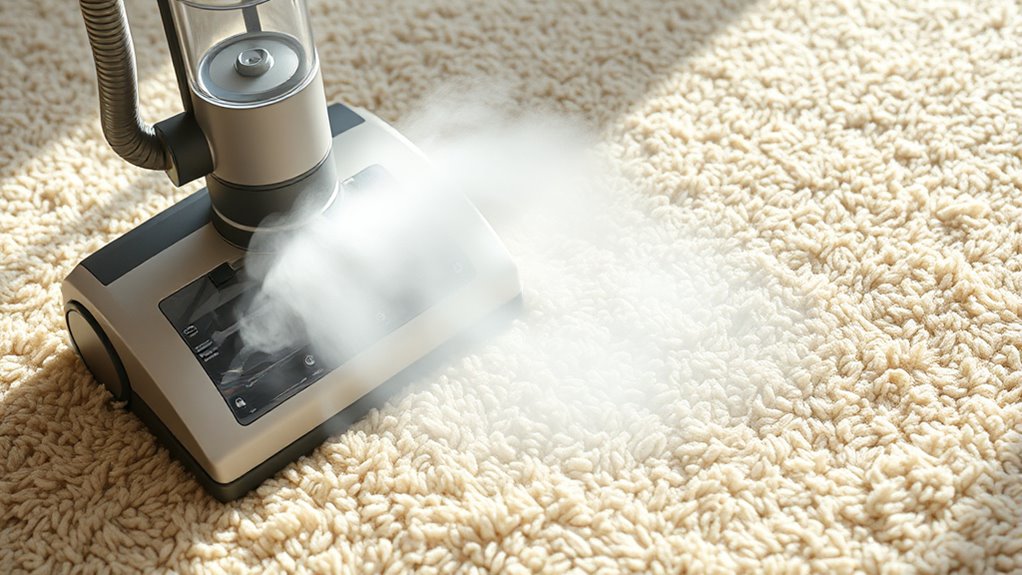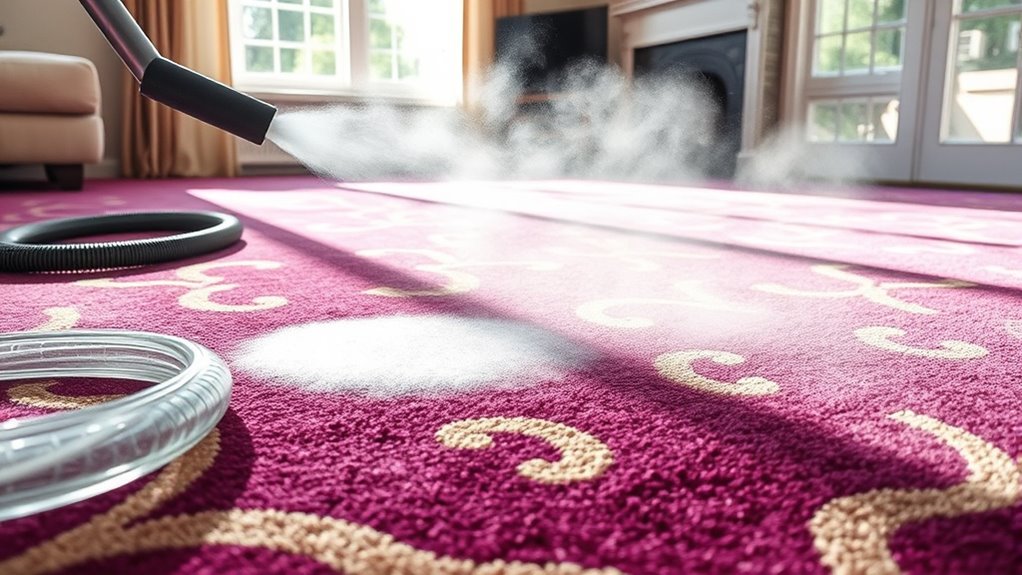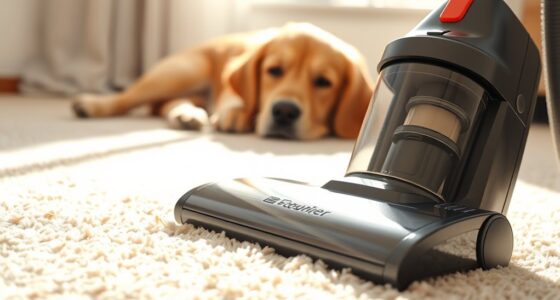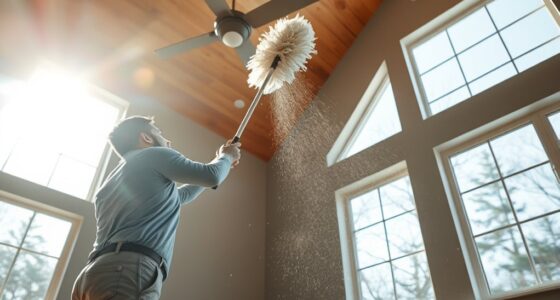To achieve an allergy-friendly deep clean with steam cleaning, make certain your vacuum is well-maintained to remove surface dirt and allergens before steaming. Use a steam cleaner with adjustable settings to target deep-seated dust, mites, and bacteria without damaging delicate fibers. Proper drying prevents mold growth, and understanding your carpet’s fiber type helps customize the process for the best results. Keep your home healthier—continue to discover how proper techniques can make a difference.
Key Takeaways
- Regular vacuum maintenance removes surface dirt and allergens before steam cleaning, enhancing allergy relief.
- Adjust steam cleaner settings to use high temperature and appropriate moisture levels for deep allergen elimination.
- Use a steam cleaner with adjustable pressure to effectively kill bacteria, dust mites, and mold spores.
- Properly dry carpets after cleaning to prevent mold growth and allergen buildup.
- Understanding fiber types ensures gentle, effective cleaning that preserves carpet integrity and reduces allergen trapping.

Are you tired of stubborn stains and lingering odors in your carpets? If so, steam cleaning offers a powerful solution that goes beyond surface dirt. Before diving into the deep cleaning process, it’s essential to pay attention to vacuum maintenance. Regularly maintaining your vacuum cleaner ensures it performs efficiently, removing loose dirt, dust, and allergens before you even start steaming. A well-maintained vacuum prevents debris from getting pushed deeper into the fibers during cleaning, reducing the risk of damage and improving overall results. Make sure to replace filters and empty the canister frequently, and check the brushes for wear. This simple step enhances your carpet’s readiness for steam cleaning, making the process more effective and efficient.
Maintaining your vacuum ensures effective, damage-free steam cleaning for cleaner, fresher carpets.
Understanding your carpet’s fiber types is equally important. Different fibers—such as wool, nylon, polyester, or olefin—respond differently to cleaning methods. Wool, for example, is delicate and can shrink or become damaged if exposed to excessive moisture or heat. Nylon carpets are more resilient but still benefit from gentle cleaning to preserve their appearance. Polyester fibers are often stain-resistant but can trap dirt more easily if not cleaned properly. Knowing the fiber type helps you choose the correct steam cleaning technique and temperature, ensuring you don’t unintentionally harm your carpet. Consulting manufacturer instructions or testing a small area first can help you tailor your approach, preventing costly mistakes. Additionally, understanding the contrast ratio of your cleaning equipment can help you select the most effective settings for deep sanitation.
When you’re ready to steam clean, remember that the goal is to penetrate deep into the fibers and lift out embedded dirt and allergens. Using a high-quality steam cleaner with adjustable settings allows you to control the temperature and amount of moisture. Start by cleaning in a slow, overlapping pattern, which helps to cover every inch thoroughly. The heat and moisture work together to break down grime, kill bacteria, and loosen dust mites, making your home safer and healthier. The steam not only cleans but also sanitizes, which is especially beneficial if you suffer from allergies or asthma.
Once you’ve finished steaming, give your carpets some time to dry completely before walking on them. Proper drying prevents mold growth and ensures the cleaning results last longer. Regular maintenance—both of your vacuum and understanding your carpet’s fiber types—will make your deep cleaning efforts more effective and help your carpets stay fresh, clean, and allergy-friendly for years to come.
Frequently Asked Questions
Is Steam Cleaning Safe for All Types of Carpets?
Steam cleaning is generally safe for most carpet fiber types, but you should check your carpet’s care label first. It’s a safe method when done properly, as it uses high-temperature steam to sanitize and deep clean without harsh chemicals. However, delicate fibers like silk might be damaged by the heat. Always guarantee steam cleaning safety by using the right equipment and settings for your specific carpet to avoid any damage.
How Often Should I Steam Clean My Carpets?
You should steam clean your carpets every 6 to 12 months to maintain their lifespan and guarantee a thorough clean. Regular cleaning prevents dirt buildup, allergens, and stains, keeping your home healthier. If you have pets, kids, or allergies, consider cleaning more often. Proper cleaning frequency preserves your carpet’s appearance and extends its durability, making your space more inviting and allergen-free.
Can Steam Cleaning Remove Pet Odors Completely?
Think of steam cleaning as your secret weapon, much like a knight’s shield. It can substantially reduce pet hair and remove odors, but it might not eliminate them entirely. For best odor removal, combine steam cleaning with proper ventilation and enzyme-based deodorizers. While steam penetrates deep to break down odors, persistent smells may require repeated treatments. Keep at it, and you’ll restore freshness to your space.
Does Steam Cleaning Use Any Harsh Chemicals?
No, steam cleaning typically doesn’t use harsh chemicals, making it a chemical-free cleaning option. It relies on high-temperature steam to sanitize and clean your carpets naturally. This eco-friendly method kills germs and removes dirt without introducing toxic substances. If you’re concerned about chemicals, steam cleaning is a safe choice that keeps your home healthy and allergen-free while being gentle on the environment.
How Long Does It Take for Carpets to Dry After Steam Cleaning?
After steam cleaning, expect your carpets to dry in about 6 to 12 hours, depending on factors like humidity and airflow. During this drying time, moisture evaporation occurs as the heat from the steam loosens dirt and moisture from fibers. To speed up the process, increase ventilation, use fans, or open windows. Patience guarantees your carpets dry thoroughly, preventing mold or mildew growth caused by excess moisture.
Conclusion
By choosing steam cleaning for your carpets, you’re not just cleaning—you’re transforming your home into a pristine, allergy-free oasis! Say goodbye to sneezing fits, dust mites, and hidden bacteria lurking in every fiber. This deep clean is like launching a superhero attack on dirt, leaving your carpets spotless and your air crystal clear. Don’t settle for mediocre cleaning—embrace steam cleaning and turn your home into the ultimate allergy-free paradise in just one powerful swoop!









